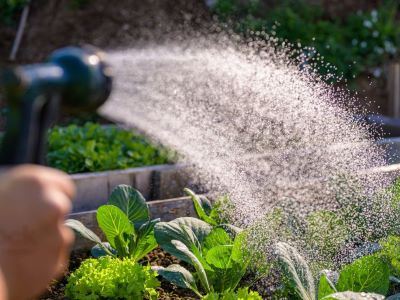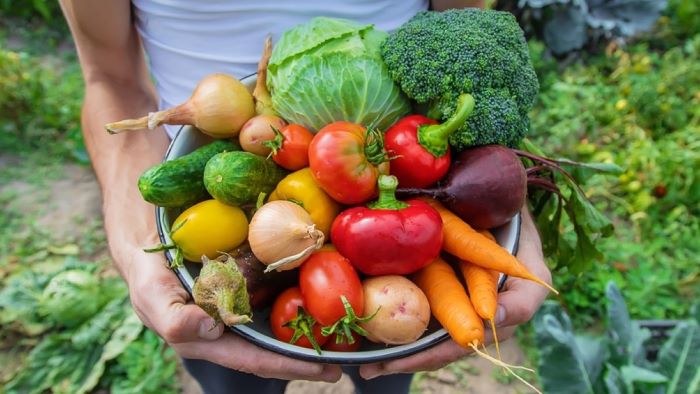If you love eating fresh vegetables, this vegetable garden post is for you. Vegetable gardening is the perfect hobby for vegetable lovers. But before digging and planting, you should know that vegetable gardening is daunting. There are many common vegetable gardening mistakes, done by gardeners, especially beginners, which can ruin your home garden or vegetable garden.
To avoid ruining your vegetable garden, you must know the most common watering blunders many gardeners make. This blog post will guide you through the process and help you avoid such mistakes in the future.
Contents
7 Watering Mistakes That Sabotage Your Vegetable Garden
As we know, watering is one of the most critical tasks for any vegetable gardener. However, it can also be among the most challenging and confusing. How much water do your vegetables need? When should you water them? How should you water them?
If you don’t know the answers to these questions, you may make some common watering mistakes that can sabotage your vegetable garden. Here are seven watering vegetable gardening mistakes to avoid for your future reference.
1. Watering Too Much or Too Little
One of vegetable gardeners’ biggest mistakes is watering their plants too much or too little. Both extremes can cause problems for your plants, such as wilting, yellowing, root rot, fungal diseases, blossom end rot, cracking, and poor yield.

So, the key is to water your plants according to their needs, which depend on several factors such as the type of plant, the stage of growth, the soil type, the weather, and the season. Furthermore, watering your vegetable garden with at least one inch of water per week is suggested, unless there is sufficient rain.
However, you should always check the soil moisture before watering by inserting your finger about two inches deep into the soil.
2. Watering the Leaves
Another common mistake is watering the leaves of your plants instead of the roots. This can happen when you use a sprinkler or a hose with a spray nozzle that sprays water over the top of your plants. While this may seem convenient and efficient, it can actually cause more harm than good.
Moreover, watering the leaves can increase the risk of fungal diseases, such as powdery mildew and blight, especially if you water in the evening or on cloudy days when the leaves stay wet for a long time. Watering in the evening or on cloudy days can also waste water by evaporating quickly or running off the soil surface.
It is suggested to water your vegetable plant at the base, where the roots are, as this will ensure that the water reaches the root zone.
3. Not Using a Rain Gauge
A rain gauge is a simple device that measures how much rain falls in your area. It can be very helpful for vegetable gardeners who want to track how much water their plants get from nature. Without a rain gauge, you may overwater or underwater your plants based on guesswork or assumptions.

Furthermore, a rain gauge can help you adjust your watering schedule according to the actual rainfall in your garden. You can buy a rain gauge from a garden center or online, or you can make one yourself using a plastic bottle or a glass jar with markings on it.
In addition, place it in an open area in your garden where it can collect rainwater without obstruction, check it regularly, and empty it after each rainfall.
4. Watering in the Heat
Watering in the day’s heat may seem like a good idea to cool down your plants and prevent them from wilting. However, this can do more harm than good. Plus, it can cause several problems for your plants, such as:
- It can cause a lot of water to evaporate before it reaches the roots or after it reaches the leaves, which means your plants will not get enough water to stay hydrated and healthy.
- Watering in the heat can also cause water droplets to act like magnifying glasses on the leaves, concentrating the sun’s rays and burning them. This can damage the leaf tissue and reduce photosynthesis.
- Also lead to sudden changes in soil temperature and moisture levels, which can shock and stress the roots of your plants.
The best time to water your plants is in the morning. When the temperature is cooler and the sun is less intense. This allows your plants to absorb enough water before the heat sets in and reduce evaporation losses.🌱🌞💦👍
5. Not Checking Soil Moisture
Some vegetable gardeners rely on visual cues or schedules to decide when to water their plants. However, these methods are not very reliable or accurate. The only way to know if your plants need water is to check the soil moisture level regularly.

As mentioned earlier, you can do this by inserting your finger about two inches deep into the soil near each plant. If it feels dry, then water; if it feels moist, then wait. Furthermore, you can also use a soil moisture meter or probe to measure the soil moisture level more precisely.
These devices are available at garden centers or online and can help you water your plants more efficiently and effectively.
6. Overwatering Seedlings
Well, seedlings are young plants that have just sprouted from seeds. They are very delicate and sensitive to water stress. So, overwatering seedlings can cause several problems, such as:
- Damping off: This is a fungal disease, which can cause the stems of seedlings to rot and collapse at the soil level. It is caused by excess moisture and poor air circulation in the soil.
- Legginess: it is a condition where seedlings grow tall and spindly with weak stems and few leaves. It is caused by insufficient light and too much water.
- This leads to root rot issues, where the roots of seedlings turn brown and mushy and stop functioning. It is caused by too much water and a lack of oxygen in the soil.
To avoid overwatering seedlings, you should water them only when the top inch of the soil feels dry to the touch. You should also use well-drained soil or potting mix, avoid watering from above, and provide adequate light and ventilation for your seedlings.
7. Watering With Hard or Salty Water
The quality of water that you use to water your plants can also affect their health and growth. This is because hard water contains high levels of minerals, such as calcium and magnesium. On the other hand, salty water contains high levels of salt, such as seawater or brackish water. Both types of water can cause problems for your plants, such as:
- Hard water can cause minerals to accumulate in the soil and on the leaves of your plants. This can reduce the availability of nutrients and impact the soil’s pH level.
- Salty water can cause salt to accumulate in the soil and on the leaves of your plants. This can draw water out of the plant cells and cause dehydration, wilting, browning, and stunted growth.
To avoid watering with hard or salty water, you should use rainwater, distilled water, or filtered water for your plants. You can also add organic matter, such as compost or peat moss, to your soil to improve its drainage and buffer its pH level.
Plus, you can also flush the soil with fresh water occasionally to leach out excess minerals or salt.
Related Post:
FAQs
How often to water vegetable garden?
The frequency of watering your vegetable garden depends on several factors, such as the type of plants, the soil type, the weather, and the season. A general rule of thumb is to water your vegetable garden with at least one inch of water per week, unless there is sufficient rain.
What is the best time to water vegetable garden?
The best time to water your vegetable garden is in the morning, when the temperature is cooler and the sun is less intense. This will allow your plants to absorb enough water before the heat sets in and reduce evaporation losses. Watering in the morning also helps prevent fungal diseases by allowing wet foliage to dry quickly.
How much to water vegetable garden?
The amount of water your vegetable garden needs depends on several factors, such as the type of plants, the stage of growth, the soil type, the weather, and the season. A general rule of thumb is to water your vegetable garden with at least one inch of water per week, unless there is sufficient rain. However, you should always check the soil moisture before watering by inserting your finger about two inches deep into the soil. If it feels dry, then water; if it feels moist, then wait.
What is a good vegetable garden layout?
A good vegetable garden layout is one that maximizes the use of space, sunlight, and soil quality. Some principles to follow when laying out a vegetable garden are: Start small and grow only what you love to eat, Mix sun-loving and shade-tolerant plants so that the former provide shade for the latter, etc…
List of vegetable garden ideas
Grow salad greens in a window box or a hanging basket for easy access and harvest.
You can create a pizza garden by planting tomatoes, basil, oregano, peppers, and onions in a circular bed or a large container. Build a raised bed or a raised row for better drainage and soil quality.
Conclusion
We hope you enjoyed this blog post and learned something new about vegetable gardening. By avoiding these common vegetable gardening mistakes, you can increase your chances of growing healthy and delicious vegetables that you and your family can enjoy.
As we know, vegetable gardening is a fun and rewarding activity that can enrich your life in many ways. So don’t be afraid to try it, and don’t give up if you encounter challenges.
Remember, every gardener makes mistakes, but the most essential thing is learning from them and improving. Happy gardening!

Hello, I’m Rose Lehman, the content writer of cozynest. I have been a gardener for over 5 years, and I have a certificate in master gardening from the Oregon State University Extension Service. I enjoy writing about all aspects of gardening, from the basics to the advanced, and from the practical to the creative. I also love to explore different types of gardens, cultures, and styles, and share them with our readers. My goal is to inspire and inform our audience, and help them grow their own cozynest.


1 thought on “Avoid These Vegetable Gardening Mistakes!”